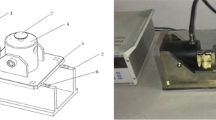Abstract
2D tactile arrays may be integrated into handheld devices or VR controllers to enhance user experience, for example, with touch communication for collaborative tasks. Multiple tactors (tactile elements) may be activated in combination to approximate a vibration point (virtual tactor) having arbitrary position and intensity. We studied the combination of intensities from multiple tactors to guide virtual tactor rendering approaches. Subjects matched perceived loudness of multi-tactor vibrations to a reference tactor. The multi-tactor vibrations corresponded to overall perceived positions halfway between tactor pairs and in the center of a 2D 4-tactor group. Results inform the relationship between tactor signal level and perceived loudness at these critical positions. The relationship leads us to propose a nonlinear 2D rendering approach, provides a basis for assessment of existing rendering techniques, and lays a foundation for further study of 2D array rendering.
Access this chapter
Tax calculation will be finalised at checkout
Purchases are for personal use only
Preview
Unable to display preview. Download preview PDF.
Similar content being viewed by others
References
Yang, G.-H., Jin, Y., Jin, M.-S., Kang, S.: Vibrotactile Cradle for Smart Cell-phone Providing Spatial and Directional Cues. In: International Conference on Robotics and Biomimetics, Phuket, Thailand (2011)
Yatani, K., Gergle, D., Truong, K.N.: Investigating Effects of Visual and Tactile Feedback on Spatial Coordination in Collaborative Handheld Systems. In: ACM Conference on Computer Supported Cooperative Work (CSCW 2012), Seattle, WA (2012)
Ryu, D., Yang, G.-H., Kang, S.: T-hive: Vibrotactile Interface Presenting Spatial Information on Handle Surface. In: IEEE International Conference on Robotics and Automation, Kobe, Japan (2009)
Seo, J., Choi, S.: Initial study for creating linearly moving vibrotactile sensation on mobile devices. In: IEEE Haptics Symposium, Waltham, MA (2010)
Yang, G.-H., Ryu, D., Kang, S.: Vibrotactile Display for Hand-held Input Device Providing Spatial and Directional Information. In: WorldHaptics, Salt Lake City, UT, USA (2009)
Borst, C.W., Cavanaugh, C.D.: Touchpad-Driven Haptic Communication using a Palm-Sized Vibrotactile Array with an Open-Hardware Controller Design. In: Eurohaptics, Munich, Germany (2004)
Brave, S., Dahley, A.: inTouch: a medium for haptic interpersonal communication. In: SIGCHI, Atlanta, GA, USA (1997)
Rantala, J., Salminen, K., Raisamo, R., Surakka, V.: Touch Gestures in Communicating Emotional Intention via Vibrotactile Stimulation. International Journal of Human-Computer Studies 71(6), 679–690 (2013)
Haans, A., IJsselsteijn, W.: Mediated social touch: a review of current research and future directions. Virtual Reality 9(2), 149–159 (2006)
Huisman, G., Darriba Frederiks, A., van Dijk, E., Heylen, D., Kröse, B.: The TaSST – Tactile Sleeve for Social Touch. In: World Haptics Conference, Daejon, Korea (2013)
Israr, A., Poupyrev, I.: Tactile brush: Drawing on skin with a tactile grid display. In: SIGCHI Conference on Human Factors in Computing Systems, New York, NY (2011)
Oakley, I., Kim, Y., Lee, J., Ryu, J.: Determining the feasibility of forearm mounted vibrotactile displays. In: Haptic Interfaces for Virtual Environment and Teleoperator Systems, Arlington, VA, USA (2006)
Rahal, L., Cha, J., El Saddik, A., Kammerl, J., Steinbach, E.: Investigating the influence of temporal intensity changes on apparent movement phenomenon. In: International Conference on Virtual Environments, Human-Computer Interfaces and Measurement Systems, Hong Kong, China (2009)
Alles, D.S.: Information Transmission by Phantom Sensations. IEEE Transactions on Man-Machine Systems 11(1), 85–91 (1970)
Sherrick, C.E.: Effects of Double Simultaneous Stimulation of the Skin. American Journal of Psychology 77(1), 42–53 (1964)
von Békésy, G.: Funneling in the Nervous System and its Role in Loudness and Sensation Intensity on the Skin. Journal of The Acoustical Society of America 30(5), 399–412 (1958)
Gescheider, G.A.: Information-processing channels in the tactile sensory system: a psychophysical and physiological analysis. Psychology Press, New York (2009)
Sherrick, C., Rogers, R.: Apparent Haptic Movement. Perception and Psychophysics 1(6), 175–180 (1966)
Cha, J., Rahal, L., El Saddik, A.: A Pilot Study on Simulating Continuous Sensation with Two Vibrating Motors. In: IEEE International Workshop on Haptic Audio Visual Environments and their Applications, Ottawa, Canada (2008)
Borst, C.W., Asutay, A.: Bi-level and Anti-aliased Rendering Methods for a Low-Resolution 2D Vibrotactile Array. In: IEEE WorldHaptics, Pisa, Italy (2005)
Borst, C.W., Baiyya, V.B.: A 2D Haptic Glyph Method for Tactile Arrays: Design and Evaluation. In: Worldhaptics (2009)
Borst, C.W., Baiyya, V.B.: Enhancing VR-based Visualization with a 2D Vibrotactile Array. In: ACM Virtual Reality Software and Technology (VRST), Newport Beach, CA, USA (2007)
Gescheider, G.: The classical psychophysical methods. In: Psychophysics: The Fundamentals, pp. 45–72. Psychology Press, Nahwah (2009)
Engineering Acoustics Inc., ATAC Tactors (August 15, 2014) , http://www.atactech.com
Author information
Authors and Affiliations
Editor information
Editors and Affiliations
Rights and permissions
Copyright information
© 2014 Springer International Publishing Switzerland
About this paper
Cite this paper
Lipari, N.G., Borst, C.W. (2014). Study of 2D Vibration Summing for Improved Intensity Control in Vibrotactile Array Rendering. In: Bebis, G., et al. Advances in Visual Computing. ISVC 2014. Lecture Notes in Computer Science, vol 8888. Springer, Cham. https://doi.org/10.1007/978-3-319-14364-4_31
Download citation
DOI: https://doi.org/10.1007/978-3-319-14364-4_31
Publisher Name: Springer, Cham
Print ISBN: 978-3-319-14363-7
Online ISBN: 978-3-319-14364-4
eBook Packages: Computer ScienceComputer Science (R0)




